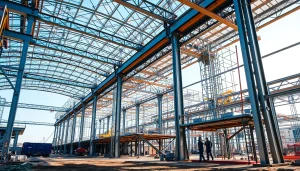Understanding Precision Die Cutting
Precision die cutting is an essential manufacturing process that creates highly accurate and consistent shapes from various materials, primarily used in a multitude of industries ranging from automotive to healthcare. By utilizing precision die cutting, manufacturers can produce intricate parts with tight tolerances, thus enhancing product quality and performance.
What is Precision Die Cutting?
Precision die cutting refers to the process of cutting materials into specific shapes with high accuracy, using a die—a specialized tool used for shaping materials. The die is placed on the material and pressed down either manually or mechanically to create the desired cut shape. Unlike traditional cutting methods, precision die cutting achieves uniformity across production runs, ensuring that each cut part adheres to strict specifications.
Importance of Precision in Manufacturing Processes
The importance of precision in manufacturing cannot be overstated. High precision in die cutting ensures that parts fit together seamlessly, which is particularly crucial in industries where safety and performance rely on exact specifications. In automotive manufacturing, for example, precise die-cut parts ensure that components like trims or insulation fit perfectly, reducing assembly times and errors. Moreover, the consistency offered by precision die cutting minimizes waste and maximizes material use, contributing to more sustainable manufacturing practices.
Key Applications of Precision Die Cutting
Precision die cutting has diverse applications across various sectors:
- Automotive Industry: Used for creating parts such as gaskets, insulation, and seals.
- Medical Sector: Essential for producing components such as surgical instruments, bandages, and device casings.
- Packaging: Widely used for crafting custom packaging solutions, such as boxes and labels that require precision to function optimally.
- Electronics: Involves cutting components for devices, circuit boards, and insulation materials.
Types of Precision Die Cutting Techniques
Flatbed Die Cutting Overview
Flatbed die cutting is a technique where a hydraulic press brings the die down onto the materials laid flat. It is ideal for larger sheet materials and provides excellent precision for low to medium production runs. The process is generally slower than other techniques but is highly effective for thicker materials. Flatbed die cutting is commonly used in packaging and label manufacturing.
Rotary Die Cutting Explained
Rotary die cutting involves a cylindrical die, which rotates to cut materials continuously as they pass through. This method is particularly beneficial for high-volume production runs because it allows for faster processing speeds and minimal waste. It is often employed in manufacturing flexible packaging, labels, and other applications requiring repetitive cuts with high accuracy.
Laser Die Cutting and Its Benefits
Laser die cutting utilizes a focused laser beam to achieve precise cuts. This technique provides unparalleled accuracy and flexibility, allowing for intricate designs with tight tolerances. It is particularly advantageous for materials that are difficult to cut with traditional dies, such as certain plastics and composites. Additionally, laser cutting produces clean edges and can engrave details during the cutting process, offering further customization options.
Choosing the Right Die Cutting Service
Assessing Quality and Capabilities
When selecting a die cutting service, it is crucial to evaluate their quality standards and capabilities. Consider factors such as machine technology, die materials, and production processes. High-quality services often employ modern equipment that ensures consistent results and can handle a variety of materials and thicknesses. Requesting samples or case studies can help assess their capabilities reliably.
Evaluating Turnaround Times and Pricing
Timeliness is a critical factor in manufacturing. Evaluate turnaround times by discussing schedules upfront and understanding how they align with your project timelines. Pricing should also be transparent, considering the complexity of the design and material costs. Keep in mind that the cheapest option might not always provide the best quality; prioritizing a balance between cost and quality will yield better long-term results.
Identifying Industry-Specific Needs
Different industries have unique requirements that affect die cutting needs. For example, the medical industry may require additional certifications and cleanliness standards, while the automotive sector might focus more on durability and performance specifications. It’s essential to choose a service that understands your industry’s needs and can tailor their offerings accordingly.
Best Practices for Designing Die Cut Parts
Design Considerations for Precision
Effective design is critical for ensuring precision in die cutting. Some best practices include:
- Choose Simple Designs: Complex shapes can be implemented but may increase costs and production time.
- Incorporate Tolerances: Specify acceptable tolerances based on the part’s application, understanding that tighter tolerances may require more advanced machinery.
- Layering Considerations: Design should consider how materials will behave in layers, especially when stacking or joining parts after cutting.
Material Selection for Optimal Results
The choice of material is a crucial factor in achieving the desired results. Commonly used materials in precision die cutting include:
- Paper and Paperboard: Frequently used in packaging and labeling.
- Plastics: Versatile and used for a variety of applications, including electronics and medical devices.
- Foams: Often utilized for insulation and cushioning products in automotive and consumer goods.
Choosing the right material not only impacts the cutting process but also the functionality and durability of the final product.
Common Challenges and Solutions
Die cutting is not without its challenges. Here are some common issues and solutions:
- Material Waste: Minimize waste by optimizing the layout of parts on the sheet before cutting.
- Inconsistent Cuts: Regular monitoring of machinery and maintenance can prevent this issue.
- Complex Designs: Experiment with prototyping to refine designs before mass production.
Future Trends in Precision Die Cutting
Technological Innovations in Die Cutting
The world of precision die cutting is experiencing rapid technological advancements. Innovations such as automated systems, advanced software for design and layout, and high-speed cutting technologies are transforming the industry. These developments enhance precision, reduce waste, and cut down production times.
Sustainability in Die Cutting Practices
Sustainability is becoming increasingly important in manufacturing. Precision die cutting can contribute to more sustainable practices through techniques that reduce material waste and energy consumption. The adoption of recyclable materials and eco-friendly processes is gaining traction, reflecting a shift toward greener manufacturing solutions.
The Impact of Automation on Die Cutting Processes
Automation within die cutting processes is reshaping the industry. Automated systems can streamline operations, improve productivity, and reduce human error. The integration of robotics in material handling, cutting, and sorting ensures a consistent output and allows for a versatile response to production demands.







